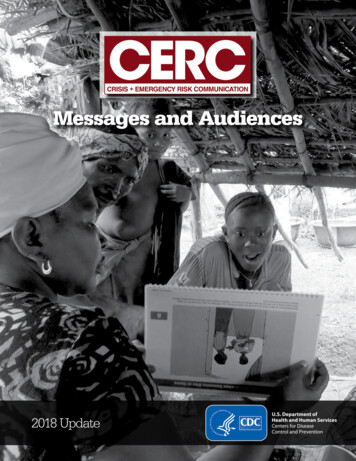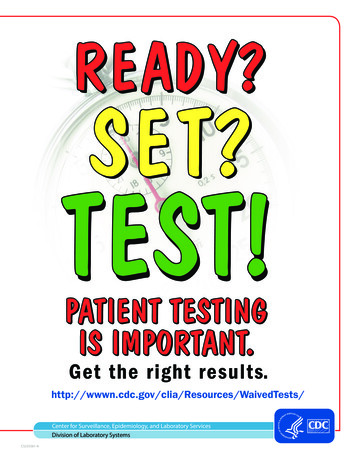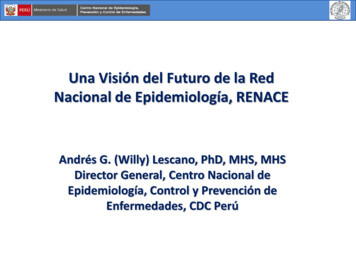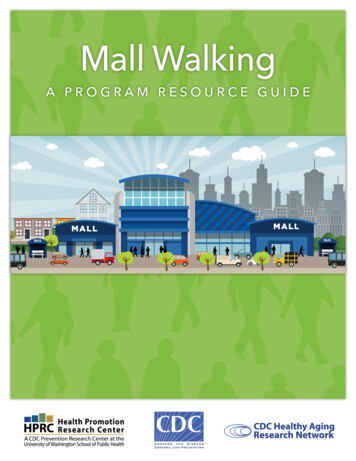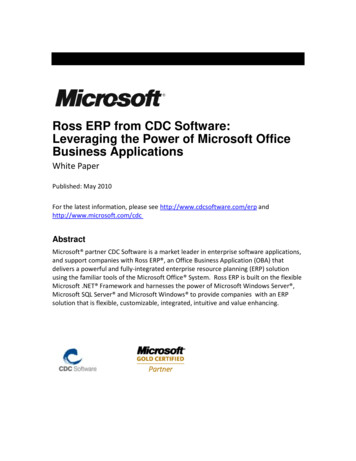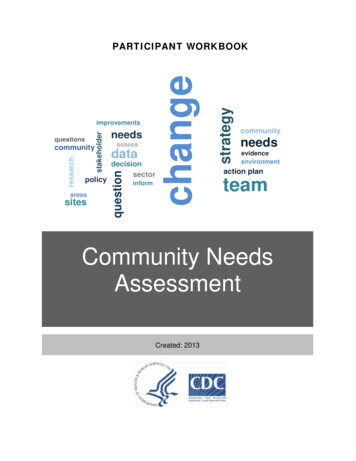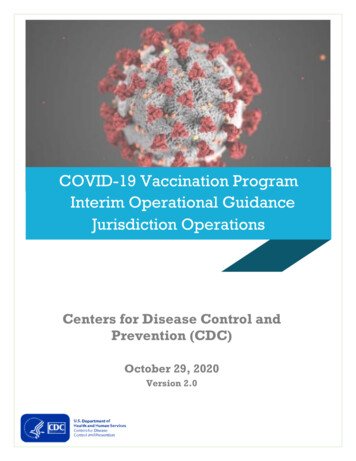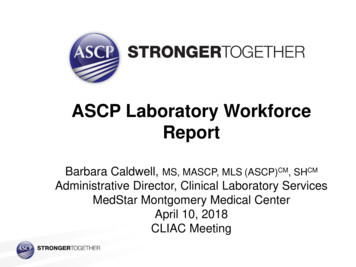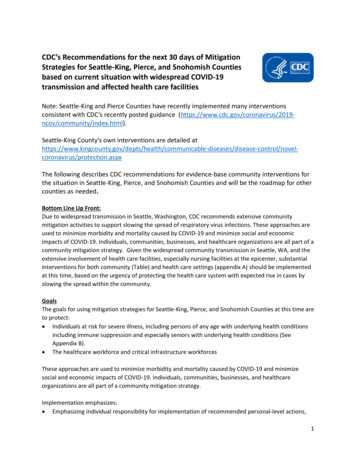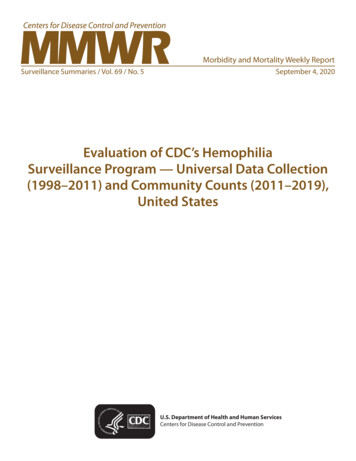
Transcription
Morbidity and Mortality Weekly ReportSurveillance Summaries / Vol. 69 / No. 5September 4, 2020Evaluation of CDC’s HemophiliaSurveillance Program — Universal Data Collection(1998–2011) and Community Counts (2011–2019),United StatesU.S. Department of Health and Human ServicesCenters for Disease Control and Prevention
Surveillance SummariesCONTENTSBackground.2Comparison of UDC (1998–September 2011) andCommunity Counts (October 2011–Present).4Evaluation of UDC and Community Counts.9Future Directions. 16Conclusion. 16References. 17The MMWR series of publications is published by the Center for Surveillance, Epidemiology, and Laboratory Services, Centers for Disease Control and Prevention (CDC),U.S. Department of Health and Human Services, Atlanta, GA 30329-4027.Suggested citation: [Author names; first three, then et al., if more than six.] [Title]. MMWR Surveill Summ 2020;69(No. SS-#):[inclusive page numbers].Centers for Disease Control and PreventionRobert R. Redfield, MD, DirectorAnne Schuchat, MD, Principal Deputy DirectorChesley L. Richards, MD, MPH, Deputy Director for Public Health Science and SurveillanceRebecca Bunnell, PhD, MEd, Director, Office of ScienceArlene Greenspan, PhD, Acting Director, Office of Science Quality, Office of ScienceMichael F. Iademarco, MD, MPH, Director, Center for Surveillance, Epidemiology, and Laboratory ServicesMMWR Editorial and Production Staff (Serials)Charlotte K. Kent, PhD, MPH, Editor in ChiefChristine G. Casey, MD, EditorMary Dott, MD, MPH, Online EditorTerisa F. Rutledge, Managing EditorDavid C. Johnson, Lead Technical Writer-EditorCatherine B. Lansdowne, MS, Project EditorMMWR Editorial BoardMichelle E. Bonds, MBAMatthew L. Boulton, MD, MPHCarolyn Brooks, ScD, MAJay C. Butler, MDVirginia A. Caine, MDMartha F. Boyd, Lead Visual Information SpecialistMaureen A. Leahy, Julia C. Martinroe,Stephen R. Spriggs, Tong Yang,Visual Information SpecialistsQuang M. Doan, MBA, Phyllis H. King,Terraye M. Starr, Moua Yang,Information Technology SpecialistsTimothy F. Jones, MD, ChairmanKatherine Lyon Daniel, PhDJonathan E. Fielding, MD, MPH, MBADavid W. Fleming, MDWilliam E. Halperin, MD, DrPH, MPHJewel Mullen, MD, MPH, MPAJeff Niederdeppe, PhDPatricia Quinlisk, MD, MPHPatrick L. Remington, MD, MPHCarlos Roig, MS, MAWilliam Schaffner, MDMorgan Bobb Swanson, BS
Surveillance SummariesEvaluation of CDC’s Hemophilia Surveillance Program — UniversalData Collection (1998–2011) and Community Counts (2011–2019),United StatesLaura A. Schieve, PhD1; Vanessa R. Byams, DrPH1; Brandi Dupervil, DHSc1; Meredith A. Oakley, DVM1; Connie H. Miller, PhD1;J. Michael Soucie, PhD1; Karon Abe, PhD1; Christopher J. Bean, PhD1; W. Craig Hooper, PhD11Divisionof Blood Disorders, National Center on Birth Defects and Developmental Disabilities, CDCAbstractProblem/Condition: Hemophilia is an X-linked genetic disorder that primarily affects males and results in deficiencies in bloodclotting proteins. Hemophilia A is a deficiency in factor VIII, and hemophilia B is a deficiency in factor IX. Approximately onein 5,000 males are born with hemophilia, and hemophilia A is about four times as common as hemophilia B. Both disorders arecharacterized by spontaneous internal bleeding and excessive bleeding after injuries or surgery. Hemophilia can lead to repeatedbleeding into the joints and associated chronic joint disease, neurologic damage, damage to other organ systems, and death. Althoughno precise national U.S. prevalence estimates for hemophilia exist because of the difficulty identifying cases among persons whoreceive care from various types of health care providers, two previous state-based studies estimated hemophilia prevalence at 13.4and 19.4 per 100,000 males. In addition, these studies showed that 67% and 82% of persons with hemophilia received care in afederally funded hemophilia treatment center (HTC), and 86% and 94% of those with the most severe cases of hemophilia (i.e.,those with the lowest levels of clotting factor activity in the circulating blood) received care in a federally funded HTC. As ofJanuary 2020, the United States had 144 HTCs.Period Covered: 1998–2019.Description of the System: Surveillance for hemophilia, which is a complex, chronic condition, is challenging because of its lowprevalence, the difficulty in ascertaining cases uniformly, and the challenges in routinely characterizing and tracking associated healthcomplications. Over time, two systems involving many stakeholders have been used to conduct ongoing hemophilia surveillance.During 1998–2011, CDC and the HTCs collaborated to establish the Universal Data Collection (UDC) surveillance system. Thepurposes of the UDC surveillance system were to monitor human immunodeficiency virus (HIV) and bloodborne viral hepatitisin persons with hemophilia, thereby tracking blood safety, and to track the prevalence of and trends in complications associatedwith hemophilia. HTC staff collected clinical data and blood specimens from UDC participants and submitted them to CDC.CDC tested specimens for viral hepatitis and HIV. In 2011, the UDC surveillance system was replaced by a new hemophiliasurveillance system called Community Counts. CDC and the HTCs established Community Counts to expand laboratory testingand the collection of clinical data to better identify and track emerging health issues in persons with hemophilia.Results: This report is the first comprehensive summary of CDC’s hemophilia surveillance program, which comprises both UDCand Community Counts. Data generated from these surveillance systems have been used in the development of public health andclinical guidelines and practices to improve the safety of U.S. blood products and either prevent hemophilia-related complicationsor identify complications early. Several factors have played a role in the effectiveness of the UDC and Community Counts systems,including 1) a stable data collection design that was developed and is continually reviewed in close partnership with HTC regionalleaders and providers to ensure surveillance activities are focused on maximizing the scientific and clinical impact; 2) flexibility torespond to emerging health priorities through periodic updates to data collection elements and special studies; 3) high data qualityfor many clinical indicators and state-of-the-art laboratory testing methods for hemophilia treatment product inhibitors (developedand refined in part based on CDC research); 4) timely data and specimen collection and submission, laboratory specimen testing,analysis, and reporting; and 5) the largest and most representative sample of persons with hemophilia in the United States andone of the largest and most comprehensive data collection systems on hemophilia worldwide.Corresponding author: Laura A. Schieve, Division of Blood Disorders,National Center on Birth Defects and Developmental Disabilities, CDC.Telephone: 404-498-3888; E-mail: LSchieve@cdc.gov.Interpretation: CDC has successfully developed, implemented,and maintained a surveillance system for hemophilia. The programcan serve as an example of how to conduct surveillance for acomplex chronic disease by involving stakeholders, improving andUS Department of Health and Human Services/Centers for Disease Control and PreventionMMWR / September 4, 2020 / Vol. 69 / No. 51
Surveillance Summariesbuilding new infrastructure, expanding data collection (e.g., new diagnostic assays), providing testing guidance, establishing aregistry with specimen collection, and integrating laboratory findings in clinical practice for the individual patient.Public Health Action: Hemophilia is associated with substantial lifelong morbidity, excess premature deaths, and extensive healthcare needs throughout life. Through monitoring data from Community Counts, CDC will continue to characterize the benefitsand adverse events associated with existing or new hemophilia treatment products, thereby contributing to maximizing the healthand longevity of persons with hemophilia.BackgroundOverview of HemophiliaHemophilia refers to a group of genetic disorders resultingin deficiencies in blood-clotting proteins. Hemophilia A(also known as classic hemophilia) is a deficiency of factorVIII, and hemophilia B (also known as Christmas disease)is a deficiency of factor IX (1,2). Because both hemophilia Aand B are X-linked disorders, they primarily affect males.Although no precise national U.S. prevalence estimates existfor hemophilia because of the difficulty identifying patientswho receive care from various types of health care providers,two in-depth, state-based studies (one of persons in six statesin 1995 and one of persons in one state during 2011–2013)estimated hemophilia prevalence as 13.4 and 19.4 per 100,000males, respectively (3,4). Approximately one in 5,000 males areborn with hemophilia, with hemophilia A about four times ascommon as hemophilia B (3). Both disorders are characterizedby spontaneous internal bleeding and excessive bleeding afterinjuries or surgery. Hemophilia can lead to repeated bleedinginto the joints, which results in chronic joint disease, pain, andmobility limitations. Hemophilia bleeding also might causeneurologic damage, damage to other organ systems, and death.The extent of joint disease and other complications varies bythe severity of the hemophilia (5), which is defined based on thelevel of factor activity in the circulating blood. Thousands ofdifferent variants of the respective genes coding for factor VIIIand factor IX have been identified to cause hemophilia, leadingto variability in both the severity and bleeding phenotypesobserved for both hemophilia A and B (1,2).As early as the second century AD, references were madeto a bleeding disorder that clustered in males within certainfamilies (6). Case series of this condition were reported overthe centuries, and the term hemophilia, meaning “affinity toblood,” was first used to describe the condition in 1838. Inthe 1800s, scientists and clinicians recognized that hemophiliainvolved a deficit in the body’s coagulation processes and waslinked to genetics. However, the underlying pathophysiologyof factor VIII and factor IX deficiencies that cause hemophiliawas not understood until the 1940s and 1950s. In the 1950sand 1960s, treatment for hemophilia consisted primarily of2MMWR / September 4, 2020 / Vol. 69 / No. 5whole blood or fresh plasma transfusions, both of which hadinadequate levels of clotting factors to control severe bleeding,such as that associated with surgery or trauma.Consequently, before the 1970s, life expectancy estimates invarious developed countries for persons with severe hemophiliawere in the teens or early 20s (7). In the mid-1960s, factorVIII concentrates derived from plasma were developed, andin the 1970s, lyophilized factor VIII concentrate treatmentsrevolutionized hemophilia care, resulting in both extendedlife expectancies and vast improvements in quality of life (6).However, the gains in life expectancy for hemophilia patientswere short lived. Factor concentrates, which were preparedfrom large pools of human plasma, were contaminated andassociated with high risk for bloodborne infections, mostnotably human immunodeficiency virus (HIV), which infectedan estimated 60%–70% of persons with severe hemophilia bythe early 1980s, and hepatitis C virus (HCV), which infectednearly all persons with severe hemophilia (8). By 2002, HIVinfection and acquired immune deficiency syndrome (AIDS)resulted in the deaths of nearly 40% of the estimated 10,000persons with hemophilia living in the United States in 1977 (9).The incidence of HIV and HCV infection among personswith hemophilia decreased during the 1990s because of saferblood products (e.g., heat inactivation of HIV present intreatment products derived from human plasma) and thedevelopment of recombinant (non–blood-based) factor VIIIand factor IX products (9,10). Hemophilia patient advocates,providers, and CDC established surveillance systems totrack the safety and relative efficacy of hemophilia treatmentapproaches and to better understand the health care needs ofpersons with hemophilia.History of CDC HemophiliaSurveillance ActivitiesIn 1975, the Health Resources and Services Administration(HRSA) received a congressional appropriation of funding todevelop a program to support an integrated regional networkof hemophilia treatment centers (HTCs) (Pub L. 94–62), theprecursor to CDC’s current hemophilia surveillance activities(Box 1). The foundation of HTC care is the comprehensive caremodel, defined as the delivery of integrated, multidisciplinaryUS Department of Health and Human Services/Centers for Disease Control and Prevention
Surveillance SummariesBOX 1. History of CDC hemophilia surveillance activities 1975: Health Resources and Services Administration(HRSA) receives congressional appropriation of fundingto establish a program to support comprehensive carefor persons with hemophilia and their families througha network of regional centers called hemophiliatreatment centers (HTCs). 1983: CDC receives congressional appropriation offunding to work with HTCs to reduce the risk foracquired immunodeficiency syndrome* among personswith hemophilia and others who used blood producttreatments. 1989: CDC, HRSA, and HTCs collaborate on thedevelopment of the hemophilia minimal data set to trackhuman immunodeficiency virus risk reduction servicesat HTCs. 1995: CDC establishes the Hemophilia SurveillanceSystem to conduct population-based surveillance ofhemophilia prevalence in six states (Colorado, Georgia,Louisiana, Massachusetts, New York, and Oklahoma). 1998: CDC, in partnership with HTCs, establishes theUniversal Data Collection (UDC) surveillance system,a national, HTC-based system for longitudinal trackingof bleeding disorder complications, with a focus onbloodborne infections and joint disease. 2010: CDC convenes a stakeholder meeting to reviewthe UDC system, with a focus on possible updates tocollect data on emerging health issues. 2011: CDC, in partnership with HTCs, establishesCommunity Counts, the next (expanded) iteration ofthe HTC-based surveillance system for persons withbleeding disorders who receive care from HTCs. BecauseCommunity Counts built on UDC’s data collectionmethod for many indices, the data from both systemscan be combined to assess long-term trends.* Because the causative pathogen for AIDS was not characterized until 1984,the funding appropriated in 1983 specified risk reduction services for AIDSrather than human immunodeficiency virus.clinical care to persons with hemophilia and other bleedingdisorders and their families; comprehensive care and servicesinclude access to subspecialists, specialized laboratorydiagnostics, treatment programs, patient education, andsupport services (11–13). HRSA grant funding continues tosupport the comprehensive care model at HTCs. In addition,the HTC network became integral to establishing CDC’sfuture public health surveillance system. In 1983, Congressappropriated funding for CDC to provide AIDS risk reductionservices for persons with hemophilia and for others whoused blood-based treatment products. (Because the causativepathogen for AIDS was not characterized until 1984, thefunding appropriated in 1983 specified risk reduction servicesfor AIDS rather than HIV.) CDC established partnershipswith HTCs to develop and implement strategies to preventAIDS in persons with hemophilia. In 1989, CDC, HRSA,and the HTCs developed the hemophilia minimal datasetto track HIV risk reduction services at HTCs. In the 1990s,CDC and the HTCs expanded their activities in response tocongressional funding to develop a public health programto reduce bleeding disorder complications. In 1995, CDC,in collaboration with the health departments in six states(Colorado, Georgia, Louisiana, Massachusetts, New York,and Oklahoma), established the Hemophilia SurveillanceSystem, which was used to conduct active, population-basedsurveillance to understand the prevalence of hemophilia andits associated illnesses, complications, and deaths. Data werecollected during 1995–1999 for persons receiving care bothwithin and outside of HTCs. Among other findings, thedata indicated that approximately two thirds of persons withhemophilia who were living in these states were receiving carein an HTC, with an even higher proportion (86%) of thosewith severe hemophilia receiving care in an HTC (3). Inaddition, care in an HTC was associated with increased survival(14). A more recent study using the same population-basedmethodology in one state estimates that 82% of persons withhemophilia and 94% of those with severe hemophilia receivecare in a federally funded HTC (4).In 1998, CDC, in collaboration with the HTCs, establishedthe Universal Data Collection (UDC) surveillance system tomonitor HIV and bloodborne viral hepatitis in persons withhemophilia, thereby tracking blood safety, and to track theprevalence of and trends in complications associated withhemophilia with a focus on infectious diseases and joint disease.In 2010, CDC convened a meeting with key stakeholders inthe blood disorders community, including representatives fromHTCs and blood banks, professional medical organizations,research organizations, consumer organizations, and otherfederal health agencies, to obtain clinical perspectives onemerging health needs in the bleeding disorders population.Information from this stakeholder discussion was used todevelop the next iteration of the surveillance system. Thissystem, known as the Community Counts Public HealthSurveillance of Bleeding Disorders project (CommunityCounts), replaced UDC. Community Counts builds on UDCbut has expanded data collection in several ways. In addition totracking bloodborne infections and joint disease complications,Community Counts includes more in-depth tracking ofother hemophilia complications and hemophilia treatmentUS Department of Health and Human Services/Centers for Disease Control and PreventionMMWR / September 4, 2020 / Vol. 69 / No. 53
Surveillance Summariescomplications (e.g., antibodies [inhibitors] to treatmentproducts). Community Counts also collects additional dataon health indices (e.g., cancer and cardiovascular disease)with special consideration of health conditions relevant to thegrowing aging hemophilia population.Comparison of UDC (1998–September 2011) and CommunityCounts (October 2011–Present)Both UDC and Community Counts collect data onpersons with bleeding disorders other than hemophilia suchas von Willebrand disease. Because hemophilia was theimpetus for the development of the surveillance program,this report exclusively describes the evaluation of UDCand Community Counts surveillance systems in trackingthe hemophilia population. Neither UDC nor CommunityCounts differentially classifies males and females with factorVIII or IX deficiency. Both are reported as cases of hemophilia.Although carrier status for X-linked genetic conditions such ashemophilia has historically been considered benign, womenwith a genotype conventionally considered indicative ofhemophilia carrier status have been shown to exhibit extensiveheterogeneity in both level of circulating clotting factor activityand risk for bleeding events. Certain women produce verylittle clotting factor because of the X chromosome inactivationpattern established during the embryonic period. Moreover,even women who have only mildly low levels of circulatingclotting fac
Surveillance Program Universal Data Collection (1998 2011) and Community Counts (2011 2019), . MBA, Phyllis H. ing, Terraye M. Starr, Moua Yang, Information Technology Specialists . This report is the first comprehensive summary of CDC’s hemophilia surveillance prog


